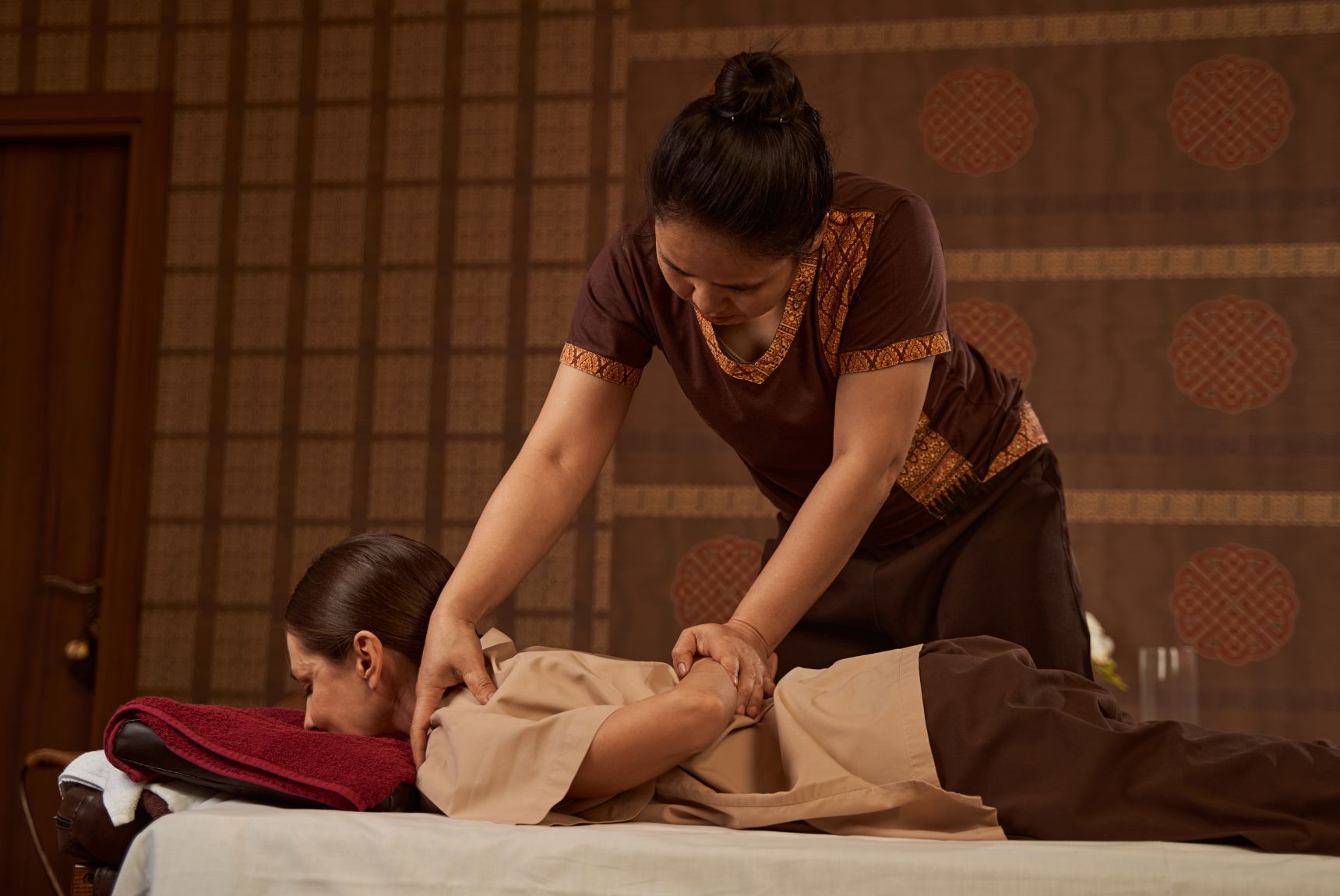In a fast-paced world filled with stress, muscle tension, and mental fatigue, finding balance and relaxation has become essential for overall well-being. One of the most effective and time-honored therapies that promote healing and rejuvenation is Thai massage.
Rooted in ancient traditions that combine elements of yoga, Ayurveda, and traditional Chinese medicine, Thai massage is far more than just a physical treatment — it’s a holistic experience for the body, mind, and spirit. Practiced for over 2,500 years, this ancient healing art continues to thrive in spas, wellness centers, and therapeutic studios worldwide, offering a powerful blend of relaxation, energy flow, and physical renewal.
What Is Thai Massage?
Thai massage, or “Nuad Boran” (meaning “ancient massage”), originated in Thailand and is deeply influenced by Buddhist philosophy and Indian Ayurvedic practices. Unlike Western massages that typically use oils and focus on muscle kneading, Thai massage is performed on a mat or firm surface while the recipient remains fully clothed in comfortable attire.
The therapist uses their hands, thumbs, elbows, forearms, and even knees or feet to apply pressure, stretch muscles, and gently guide the body into yoga-like poses. The result is a rhythmic, dynamic experience that stimulates energy flow (known as Sen lines) while promoting deep relaxation and improved flexibility.
The Philosophy Behind Thai Massage
At the core of Thai massage lies the belief that the body’s energy, or Prana (life force), flows through invisible pathways called Sen Sib. When these energy channels become blocked, it can lead to physical discomfort, fatigue, or emotional imbalance.
By applying acupressure along the Sen lines and combining stretching with mindful breathing, Thai massage restores balance, releases tension, and reawakens the body’s natural healing ability. It’s often referred to as “lazy man’s yoga” because it offers the same benefits as yoga — enhanced flexibility, improved circulation, and relaxation — without requiring active participation from the recipient.
What to Expect During a Thai Massage Session
A typical Thai massage session lasts between 60 to 120 minutes, depending on the individual’s needs. It’s a fully clothed experience that doesn’t use oils, allowing for more extensive movement and pressure work.
Here’s what you can expect:
- A Relaxing Atmosphere
The session usually takes place in a calm environment with soft lighting, tranquil music, and aromatic scents to promote relaxation.
- Comfortable Clothing
You’ll be asked to wear loose, comfortable clothing (often provided by the spa). The therapist performs the treatment on a padded mat on the floor to allow greater mobility and leverage.
- Rhythmic Pressure and Stretching
The therapist begins with gentle palm pressure along the body’s energy lines, gradually incorporating deeper pressure and stretching movements. These techniques are tailored to your comfort level and flexibility.
- Assisted Yoga-Like Poses
Throughout the session, the therapist moves your body through various stretches similar to yoga poses — twisting, pulling, and compressing different muscle groups to release tension and improve flexibility.
- Full-Body Integration
Thai massage typically focuses on the entire body, including the back, legs, arms, shoulders, neck, and head. The flow of movement creates a meditative rhythm, fostering both physical and emotional relaxation.
The Benefits of Thai Massage
Thai massage is known for its holistic healing effects, addressing physical, mental, and emotional well-being simultaneously. Here are some of its most significant benefits:
- Relieves Muscle Tension and Pain
By combining acupressure and stretching, Thai massage releases deep-seated muscle knots, improves joint mobility, and alleviates pain from conditions like backache, neck stiffness, and muscle tightness.
- Improves Flexibility and Range of Motion
The yoga-inspired stretches used in Thai massage enhance flexibility, loosen tight joints, and promote better posture — making it especially beneficial for athletes, dancers, and office workers.
- Enhances Circulation and Energy Flow
The rhythmic compression and stretching stimulate blood and lymphatic flow, delivering oxygen and nutrients throughout the body. This helps reduce fatigue and leaves you feeling refreshed and energized.
- Reduces Stress and Anxiety
The gentle, meditative flow of Thai massage calms the nervous system and encourages mindfulness. Many clients report feeling deeply relaxed and mentally clear after a session.
- Boosts Immunity and Detoxification
Improved circulation supports the body’s natural detoxification processes, helping flush out metabolic waste and strengthen immune function.
- Promotes Better Sleep
By relieving physical tension and calming the mind, Thai massage can help improve sleep quality and reduce insomnia.
Who Can Benefit from Thai Massage
Thai massage is suitable for people of all ages and lifestyles. It’s especially helpful for:
- Individuals with desk jobs or sedentary lifestyles
- Athletes seeking muscle recovery
- Those experiencing chronic stress or fatigue
- People recovering from minor injuries or muscle strain
- Anyone seeking natural relaxation and balance
However, individuals with severe health conditions — such as heart disease, fractures, osteoporosis, or pregnancy — should consult their doctor before receiving Thai massage.
Thai Massage Techniques and Styles
Over time, Thai massage has evolved into different styles, with the two most recognized being:
- Northern Style (Chiang Mai Tradition)
Known for its slow, gentle, and meditative rhythm, this style emphasizes relaxation and full-body energy balance.
- Southern Style (Bangkok Tradition)
This version uses firmer pressure and focuses on therapeutic acupressure points, making it ideal for those seeking more intense muscle work.
Most modern therapists combine both styles to create a customized experience tailored to your needs.
Thai Massage vs. Traditional Western Massage
While both promote relaxation and healing, Thai massage differs significantly from Western techniques such as Swedish or deep tissue massage.
| Aspect | Thai Massage | Western Massage |
| Technique | Stretching, acupressure, and yoga-like movements | Kneading, gliding, and muscle manipulation |
| Position | Fully clothed, on a floor mat | Undressed (covered by a sheet), on a massage table |
| Tools | Hands, thumbs, elbows, feet | Primarily hands and forearms |
| Oil Usage | None (dry massage) | Uses massage oils or lotions |
| Focus | Energy flow, flexibility, and holistic healing | Muscle relaxation and localized tension relief |
Both are highly beneficial; the choice depends on personal preference and therapeutic goals.
The Spiritual and Mindful Aspect
Beyond its physical benefits, Thai massage also nurtures the mind and spirit. Rooted in Buddhist philosophy, it encourages mindfulness, compassion, and respect — both from the therapist and the recipient.
Breathing deeply and staying present during the session promotes inner calm and connection, making Thai massage as much a meditative practice as a physical therapy.
Aftercare and Tips for the Best Experience
To make the most of your Thai massage experience:
- Hydrate well: Drink plenty of water after your session to help flush toxins released during the massage.
- Rest and relax: Avoid strenuous activity immediately afterward to let your body absorb the full benefits.
- Communicate openly: Inform your therapist about any injuries or discomfort during the session so they can adjust pressure accordingly.
- Schedule regularly: Consistent sessions can improve flexibility, reduce stress, and maintain long-term wellness.
Conclusion
Thai massage is more than just a physical treatment — it’s an ancient healing art that rejuvenates the body, refreshes the mind, and restores inner harmony. Its unique blend of stretching, pressure, and mindful breathing promotes balance, flexibility, and deep relaxation, making it one of the most holistic therapies available today.
Whether you’re seeking stress relief, muscle recovery, or a moment of peace, Thai massage offers a profound way to reconnect with your body and spirit.
In today’s modern world, where physical strain and mental tension are all too common, the ancient wisdom of Thai massage provides the perfect antidote — a path toward healing, balance, and well-being that has stood the test of time for over two millennia.



































